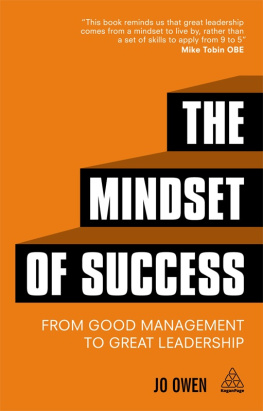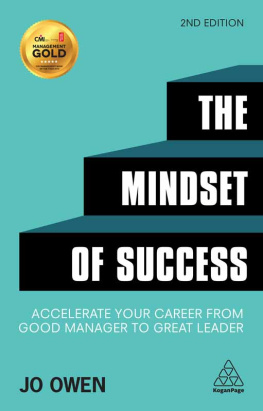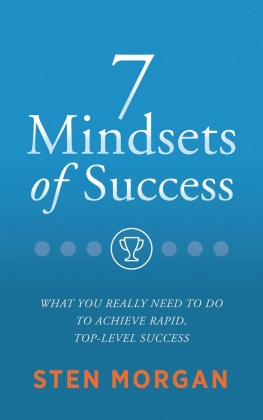SUCCESS MINDSETS
SUCCESS
MINDSETS
Your Keys to Unlocking
Greater Success in Your
Life, Work, & Leadership
RYAN GOTTFREDSON
NEW YORK
LONDON NASHVILLE MELBOURNE VANCOUVER
SUCCESS MINDSETS
Your Keys to Unlocking Greater Success in Your Life, Work, & Leadership
2020 Ryan Gottfredson
All rights reserved. No portion of this book may be reproduced, stored in a retrieval system, or transmitted in any form or by any meanselectronic, mechanical, photocopy, recording, scanning, or otherexcept for brief quotations in critical reviews or articles, without the prior written permission of the publisher.
Published in New York, New York, by Morgan James Publishing. Morgan James is a trademark of Morgan James, LLC. www.MorganJamesPublishing.com
ISBN 978-1-64279-691-9 paperback
ISBN 978-1-64279-692-6 eBook
Library of Congress Control Number: 2019943846
Morgan James is a proud partner of Habitat for Humanity Peninsula and Greater Williamsburg. Partners in building since 2006.
Get involved today! Visit
www.MorganJamesBuilds.com
TABLE OF CONTENTS
PART I
WHAT ARE MINDSETS?
Chapter 1
IS YOUR THINKING THE BEST WAY TO THINK?
Once the soul awakens, the search begins and you can never go back. From then on, you are inflamed with a special longing that will never again let you linger in the lowlands of complacency and partial fulfillment. The eternal makes you urgent. You are loath to let compromise or the threat of danger hold you back from striving toward the summit of fulfillment.
John ODonohue
What if you could know yourself at your deepest level? What if you could more fully awaken to how you see the world, why you possess the values and beliefs you have, why you have selected the goals you have set, and why you operate the way you do? Wouldnt you be able to navigate your life, work, and leadership more successfully?
This book is going to be a self-awakening journey. You are going to explore your deepest and most fundamental levels. While it may not always be pretty (I know from personal experience), you will become empowered to make the foundational changes required to cut your self-restraining mindsets and soar to new levels of success and your fullest potential. Are you ready to explore and awaken with the purpose of reshaping and restarting your life?
Setting Off on Your Self-Awakening Journey
Lets start with this question: Do you think that your thinking is the best way to think?
My guess is that you do think that your thinking is the best way to think. If you didnt think that, you would likely change your thinking.
When you think that your thinking is the best way to think, you are preventing yourself from navigating life more successfully, excelling more fully at work, and being a more effective leader.
As a leadership researcher and consultant, I see this all the time. I regularly observe leaders, managers, and employees doing what they think is best. But commonly, for many of these people, what they think of as their best is actually dysfunctional or at least limits their potential for greater success for themselves, those they lead, and their organization.
My observations are validated by rather dismal leadership statistics:
44% of employees report that their current managers do not help them be more productive.
60% of employees report that their managers damage their self-esteem.
65% of employees would prefer to have a different manager compared to more pay.
82% of employees do not trust their manager to tell the truth.
The unfortunate reality is that the majority of employees are not managed in a way that brings out their best. This isnt because leaders arent trying to do a good job, and it isnt because leaders are purposely being jerks to those whom they lead. It is because the way in which they see, think about, and process their world directs them to behave in a manner they think is best but is actually subpar. They are like a venturer using a faulty compass. Despite their best intentions and efforts, their inner compasss limitations prevent them from taking the best course, causing them to end up pursuing a less-than-ideal direction.
Meet Alan
Alan is the president of a nonprofit organization that primarily helps underprivileged individuals enhance themselves and their careers. Alan is well qualified to be the leader of this organization. He has worked in the industry for over 20 years and has a PhD in organizational psychology. He has taught leadership classes at a local university and a primary aspect of his job is to conduct leadership and personal development trainings.
Like most people, when I first met Alan I was really captivated by him. I already knew of his impressive background, but what really won me over was his confidence and charisma. Alan looks and talks like a stereotypical great leader. He also has a great ability to effectively articulate the importance and value of his organization, which motivates others to buy into and support his organizations cause. These traits have fueled double-digit growth in donations and revenues every year during his tenure and continue to fuel his ability to attract donors and employees to support and work for his organization.
To the external world, everything about the organization seems to be great. He seems to be getting results. But internally, things seem to be falling apart, largely because of Alans leadership and management. All of Alans employees are frustrated with their jobs and disengaged, and there has been a very high employee turnover rate among his employees.
Let me give you some specific examples of this discord.
First, in one instance, Alan told his employees the wrong due date for a deliverable for one of their top clients. When the client expressed frustration about not receiving the deliverable on time, Alan placed the blame on his employees.
Second, on a whim, Alan decided he wanted to roll out a new coaching service and haphazardly set a price point for the service. After hearing about the price, Taylor, the employee who would be in charge of selling the service, expressed her concerns about the price being too high. Based upon prior conversations with clients about similar products, she was under the impression that it would be really difficult to sell. Further, she was concerned that if they did sell at that particular price point, they would put the organizations reputation on the line because they would be charging a premium price on an unproven service. Until some kinks were worked out, she was worried that their clients would not receive the same or greater value than what they would be asked to pay. Upon expressing these concerns, Alan immediately got defensive, arguing that their time was worth that amount, making him come across as though he was more interested in his own value than the value they would actually be adding to their clients. Taylor, wanting to do what was best for the organization, suggested that Alan ask his advisory board about the price at an upcoming meeting. At the meeting, the board ended up agreeing with Taylor. But, unwilling to concede that he had been wrong and trying to prove that he was right, Alan was still unwilling to lower the price to the level the board and Taylor suggested. After the initial run of the coaching service, all participants agreed that while the service was beneficial, it was overpriced. It was a blow to their reputation in the marketplace.













